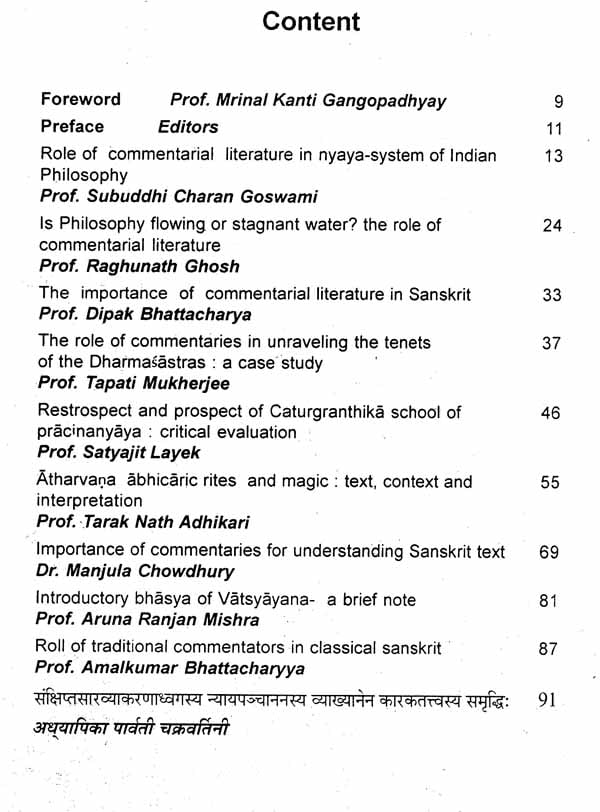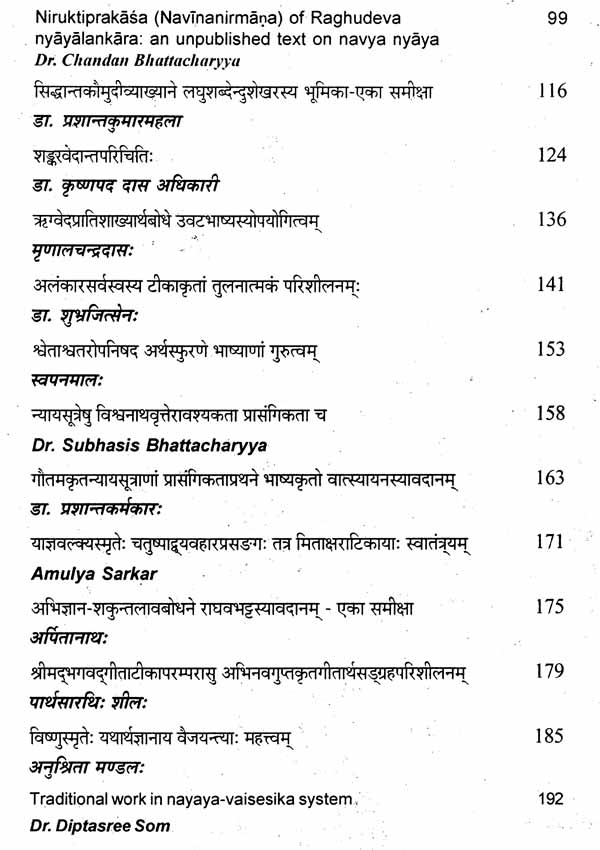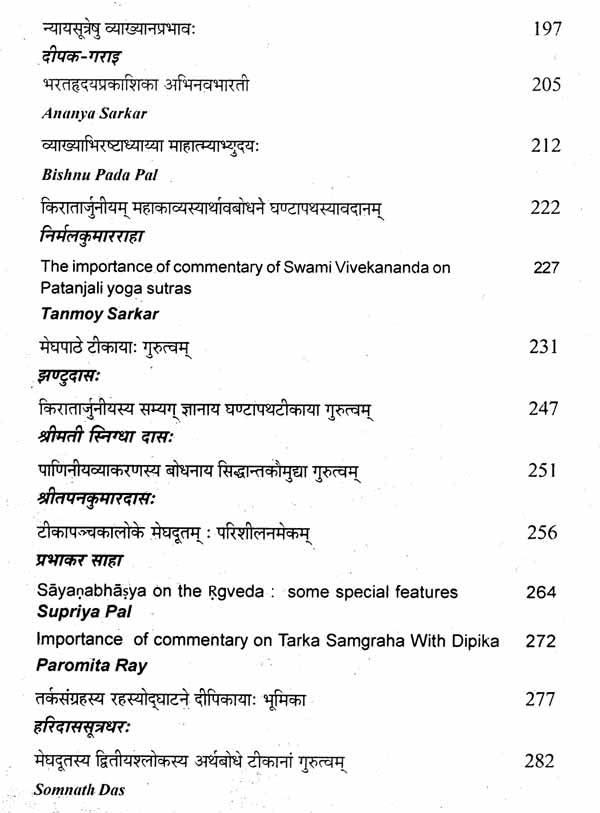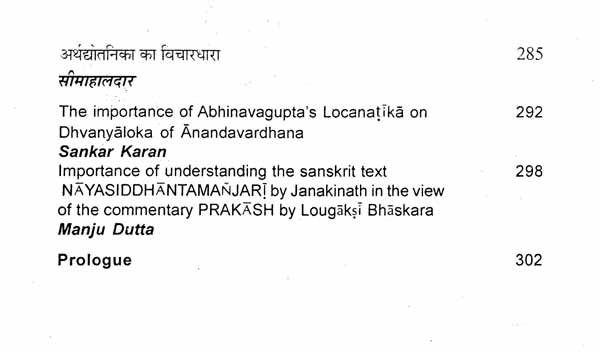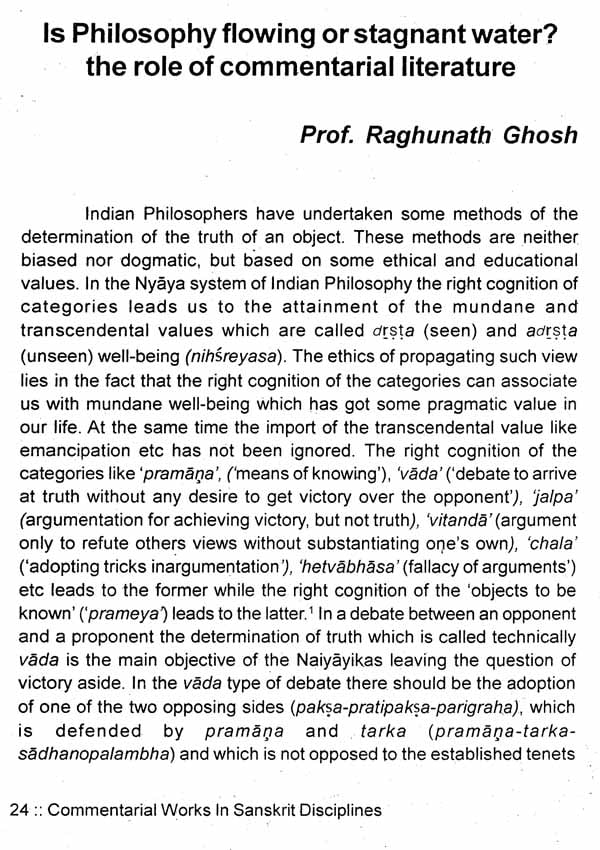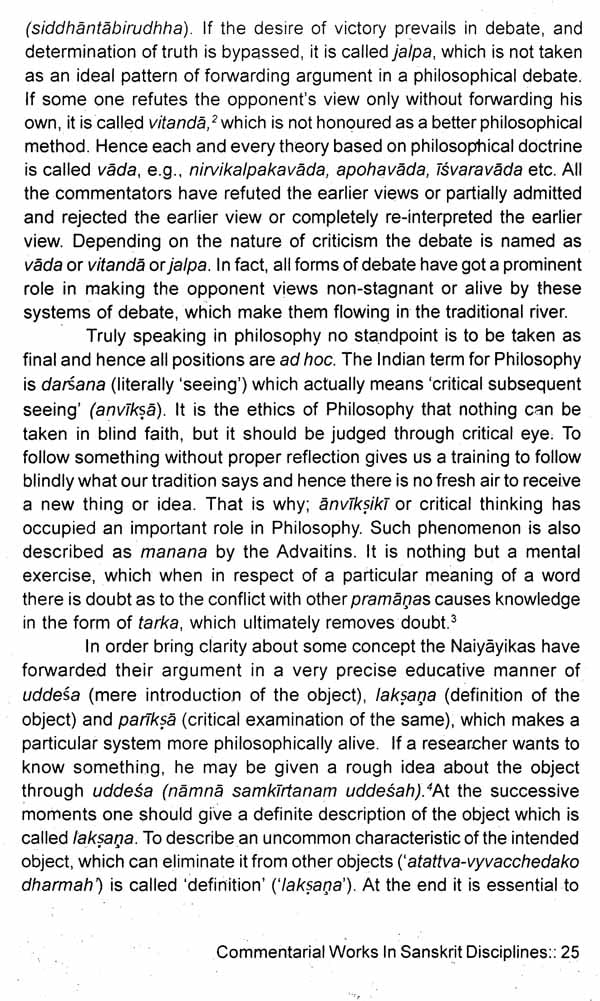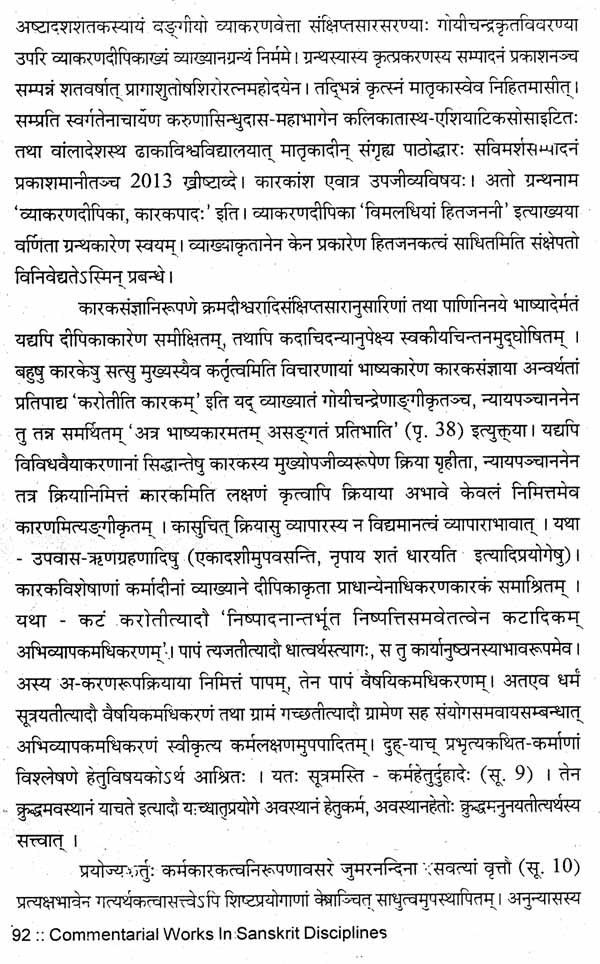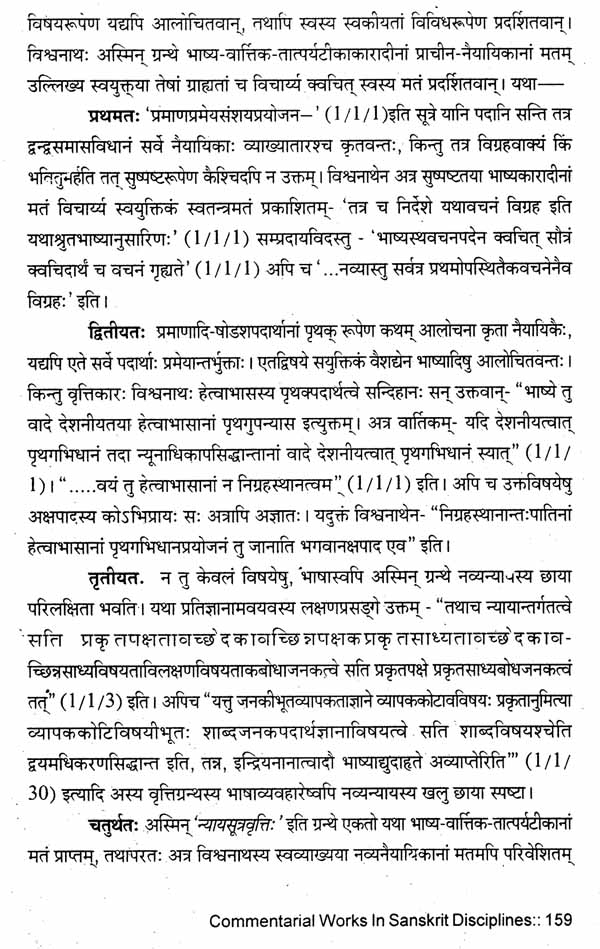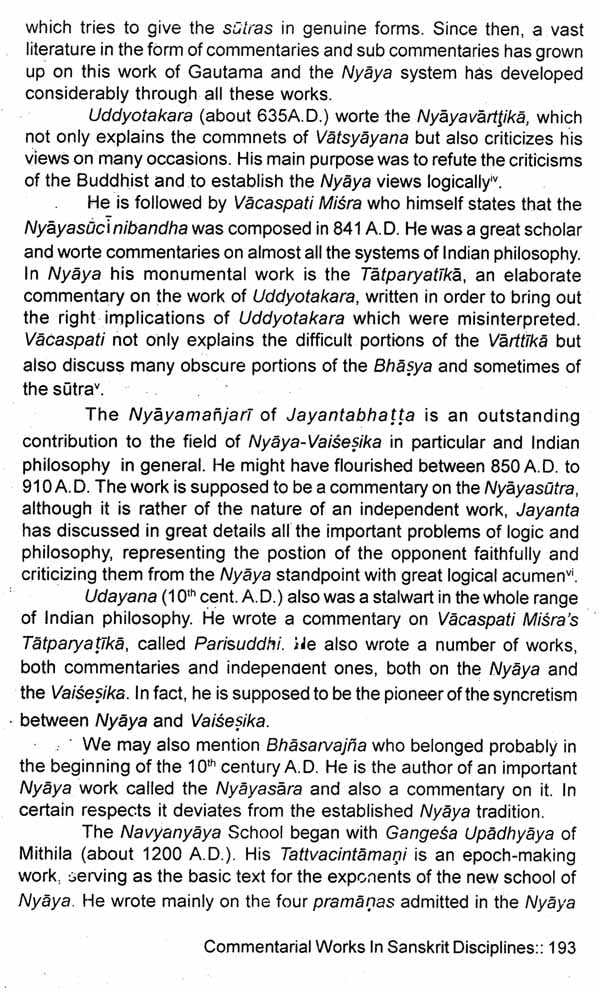
Commentarial Works in Sanskrit Disciplines (Proceedings of the International Conference)
Book Specification
| Item Code: | NAY610 |
| Author: | Chandan Bhattacharyya & Mrinal Chandan Das |
| Publisher: | The Banaras Mercantile Company, Kolkata |
| Language: | English and Sanskrit |
| Edition: | 2018 |
| ISBN: | 9788186359709 |
| Pages: | 304 |
| Cover: | HARDCOVER |
| Other Details | 8.50 X 5.50 inch |
| Weight | 450 gm |
Book Description
At the very outset of this book which is the outcome of a two-day International conference organized by the Department of Sanskrit, University of Gour Banga, Malda on 05-06 April, 2017 on " Importance of commentaries for understanding Sanskrit text."
Sanskrit literature since vedic period, down the ages, has restored the Indian wisdom in all branches of human knowledge in Sanskrit language in tens of thousands of texts. By the passage of time, these texts have been interpreted from a number of perspectives by the scholars through commentaries and expositions for the understanding of the texts. These bhasyas, Vartikas, tikas, Vrttis may be taken as sub-texts or super- texts. Even these expositions have achieved in many cases the rank of original. Though the primary object of these expositions was to understand the original texts yet in many cases. The interpretation of the same texts went contradictory differ from ane another. Subsequently, from the ocean of these commentaries, sometimes the real intention of the original text or the writer goes to the oblivion. The International conference attempts to make an interface between the text and its commentaries in order to examine the relation between the two and highlighting importance of the same in the areas of the Veda, Kavya, Vyakarana, Darsana, Dharmasastra and other branches of Sanskrit literature.
Sanskrit is now not only a mere Language bLit has become an international subject of study and research. Through the modern method of research this should be scrutinised from all possible ways. We think that, this conference has paved the way for a different angle to decipher the subject and to disseminate its different branches of study.
It is really a tedious work to see the volume through the press and we cordially extend our sincerest thanks to them, who have rendered their selfless service and support in different ways. First of all, we offer our heartfelt thanks to our Hon'ble Vice Chancellor, Professor Swagata Sen, for his support and valuable guidance in publishing the book. We also offer our heartiest gratitude to 'Acharyadeva' Professor Subuddhi Charan Goswami, ex-Dean and H.O.D., R.B.U., Kolkata for giving us his valuable suggestion and right direction. We also gratefully acknowledge cooperation received from Professor Mrinal Kanti Gangopadhyay, Formerly Asutosh Professor in Sanskrit, C.U. who have kindly consented to write 'foreword' for this volume within a very short time. We also extremely grateful to our revered 'Philosopher' and 'Guide' Professor Satyajit Layek of Calcutta University for his valuable opinion regardig this book. We must remember and thankful great personalities like Professor Dipak Bhattacharya (retd.), Santiniketan, Professor Raghunath Ghosh, UGC emeritus Professor, N.B.U., Professor Tapati Mukherjee, formerly V.C., SKBU, Professor Tarak Nath Adhikari, RBU, Professor Manjula Chowdhury, Rajshahi University, Bangladesh, Professor Aruna Ranjan Mishra, Santiniketan, ProfessorAmal Kumar Bhattacharya, Dr. Parboti Chakraborty, RBU, Dr. Prasanta Mahala, RGU and others for their contributions of research articles for enlightening us with different aspects of importantce of commentaries and after all for the successful publication of this book. We record deepest appreciation and thanks to our colleages, Dr. Subhrajit Sen, Husna Parvin and Sri Anindya Chowdhuri. Last but not the least, we offer our thanks to all the faculty Members, Officers and Official Staffs of our University, who helped us in many way in organising the conference and publishing this volume.
Mr. Ashok Kumar Shukla, the Proprietor of The Banaras Mercantile Co., Kolkata is also deserves our special thanks as he took the responsibility of printing this conference proceedings.
It is a matter of great pleasure that this volume containing the deliberations made at the conference on the importance of commentaries for understanding Sanskrit texts, organized by the Department of Sanskrit, Gour Banga University, is going to be presented to scholars, students and general public. It will enlighten us on an important intellectual tradition of India continuing from a long past almost to the present day. A look at the contents shows that scholars of repute have participated in the conference and with their critical analysis have contributed much to the academic excellence of the volume. They cover all the important branches of study, the Vedas and the upaniads, classical poetry, the schools of Indian philosophy, grammar and the like.
The indispensability of commentaries for understanding Sanskrit texts can hardly be overemphasized, and the tradition of commentary writing in India goes a long way back. Some scholars think that padapatha may be regarded as the oldest and most authoritative commentary on the Rgveda and we should not forget Yaska's Nirukta also. We cannot think of reading the Vedas without the help of Sayana, the Brahmasutra without sankara's commentary, Panini's grammar without Patanjali's exposition, works of Kalidasa without Mallinatha's comments and there is no dearth of such instances.
Naturally, commentaries are of different types, brief or elaborate, explanatory or critical. Commentators have their own manners and predilections. They follow different principles and write accordingly. Let me give some examples. One notable characteristic of our commentators is what we may call 'modesty'. They avoid claiming originality and rather emphasise that whatever they are writing is contained in the text itself, may be implicitly and they only make it explicit. This they do even when they are introducing in actuality a new concept or idea. They have also great 'reverence' for the text and never dream of criticizing or rejecting it. Of course, it is not that there is no exception. We may refer to Patanjali. In spite of recognizing the genius of the Sutrakara in no uncertain terms, in a lot of cases, he criticizes the formulation of the sutra and also, in many cases, openly rejects a sutra, without a single word in explanation or ofter a long and abstruse discussion, finally pointing to a rather easy solution of a problem.
There are also commentators who do not think it necessary to elaborate upon the general meaning of the text, but go on instead to bring out deeper or higher significances or to suggest modifications to make the text more plausible. Some again are fond of brevity and their comments practically render very little help. The examples are provided specially by the Navya-nyaya commentators like Raghunatha Siromani, Mathuranatha, Jagadisa and Gadadhara.
In spite of all this, it is undeniable that commentaries are invaluable for not only understanding texts, but they also play a great role in the development of theories and ideas. I am sure that the readers will be able to enrich themselves immensely by going through the pages of this volume.
We should be grateful to the organisers of the conference and the authorities who have extended all help to make it a success.
**Contents and Sample Pages**
